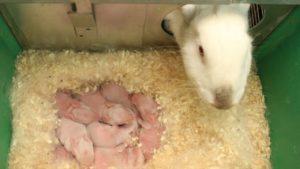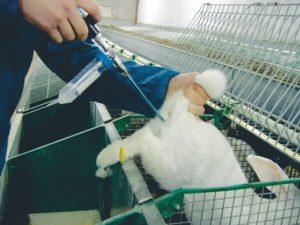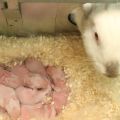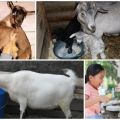What can and can not be fed to rabbits, the rules of artificial feeding
What is allowed to feed the rabbits that the rabbit refused? Babies should not be left without food, otherwise they will quickly die. They can drop a drop of cow's milk into their mouth, but it is better than goat's milk, it is more nutritious. The rubber cap from the pipette or the nipple of the rabbits will learn to suck only 3-5 days of their life. For the first week, the cubs will have to be fed artificially, dripping 1 drop of milk into their mouth 3 or 5 times a day.
Is it possible to feed rabbits without a rabbit?
After birth, rabbits feed on breast milk. They live in the same cage with a rabbit for 30-45 days. At 3-4 weeks of life, the rabbits begin to try the food that adult females eat. At 1-1.5 months, the young are transplanted into a separate cage and transferred to self-feeding.
True, sometimes the rabbits abandon their cubs, do not feed the newborns or begin to trample them, eat them. This happens if the females do not have milk, the feeding process is unpleasant, or the mothers do not receive enough wholesome and nutritious food and water. If the rabbit refuses to feed the newborns, they are immediately taken from her and placed in a separate cage.
You can add cubs to a calm lactating female. True, some rabbits do not want to feed other people's rabbits. Then the abandoned cubs are transferred to artificial feeding. They are fed milk with a pipette, a disposable syringe without a needle, or a bottle with a small nipple (as for kittens). Newborns are given cow's, goat's milk or dry formula, baby food.
How to replace rabbit milk
Born rabbits need to be fed immediately, they will not live long without food and will quickly die. Instead of rabbit milk, they can be given boiled, cooled, lukewarm cow's milk. Better - goat, it is fatter and more nutritious.

Goat milk
Little rabbits are allowed to be fed with goat milk. This product is similar in composition to mother's rabbit milk. It has a sufficient percentage of fat and all substances useful for the body. Before use, it is boiled, then cooled to 36 degrees.
Milk substitute mixtures
You can buy dry formula for feeding rabbits at pet stores or veterinary pharmacies. This is a powder similar in composition to rabbit milk.Before use, it is diluted with warm boiled water.
Baby food
Newborn rabbits are allowed to feed milk formulas for children. True, you need to choose those with a minimum of sugar and various additives. The dry mixture is diluted with warm boiled water.
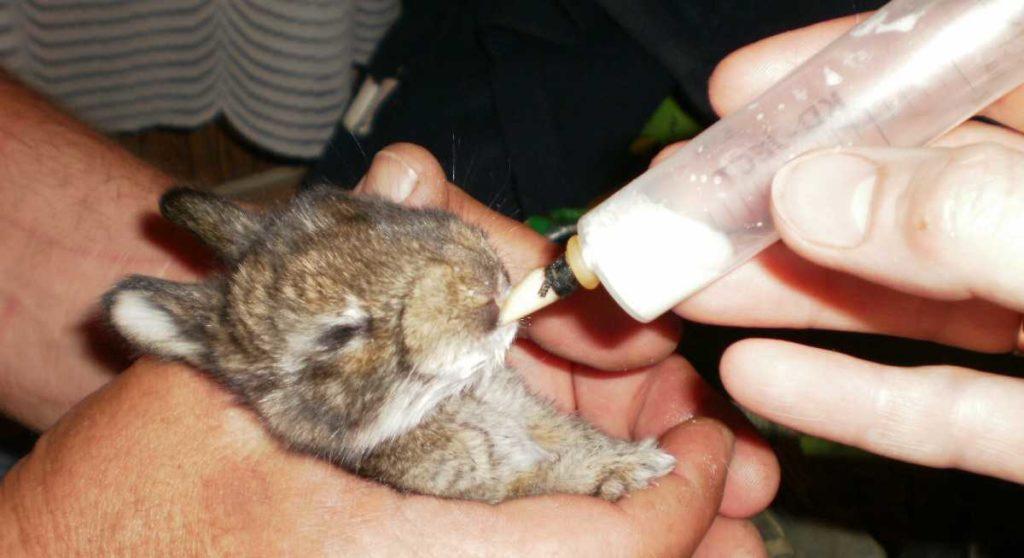
Feeding rules
Milk is given to rabbits in a warm form using a special device for feeding newborns, a bottle with a nipple, a pipette or a pharmacy disposable syringe for 10-20 ml. Do not spray liquid into the mouth. Milk is given drop by drop and it is made sure that the rabbit swallows it. You can put a rubber pipette cap on a small bottle or syringe and pierce it with a needle. It is better if the rabbit sucks milk by itself, then it will definitely not choke.
Dosage and frequency
Newborn rabbits are pipetted three times a day. They are given 1 drop or 1 milliliter of milk each time. On the second day, the animals are fed 5 times a day. In one feeding give 1 drop or 1 milliliter of milk. At one week of age, rabbits should receive 5 milliliters of food per day. After a week, the daily amount of milk is increased to 10 ml, and after another week - up to 15 ml.
Gradually, the animals are transferred to three meals a day. At 20 days of age, rabbits are given 20-30 ml of food per day. During this period, they can drink milk on their own from a saucer. At the age of one month, animals should receive 50 ml of milk per day.

Bowel stimulation
Newborn rabbits do not yet know how to empty the stomach on their own. Before each feeding, the animals should be given a gentle abdominal massage. With a damp cotton swab, the animals are rubbed the abdomen vertically in the direction from the navel to the hind legs. It is forbidden to press hard on the stomach (internal organs may be damaged). After two weeks, the rabbits will be able to empty themselves.
Feeding according to age
Feeding begins with a minimum dose of 1 ml. On the first day, a newborn rabbit should receive no more than 3 ml of feed. The rate is gradually increased.
From birth to 5 days
Newborn rabbits are fed three times a day. In one feeding they are given 1 milliliter or one drop of milk. On the second day of life, the cubs are fed five times a day. Give 1 milliliter or one drop of food. The rabbit should drink 5 ml of milk per day. You need to feed animals upright. A drop of milk mixture is pipetted into the mouth (on the tongue) with a pipette and make sure that the rabbit swallows it.

6 to 14 days (weekly-fortnightly)
From the sixth day of life, the feed rate can be doubled. Rabbits are given 2 drops or 2 ml of milk 4-5 times a day. At 14 days of age, they should drink 10-15 milliliters of milk per day. You can feed the animals three times a day (3-5 ml per feeding). At two weeks of age, rabbits must suck on their own nipple fluid.
From 15 to 30 days
When the rabbits are 15 days old, the rate can be increased again (up to 15 milliliters per day). Rabbits are given 5 drops or 5 ml of milk in one feeding. They are fed three times a day. The norm for 20-day-old animals is increasing again. On the day, a little rabbit at the 3rd week of life is obliged to receive about 20 ml of milk, that is, 7 ml per feeding. At 30 days of age, the animal should be able to drink milk from a saucer. The norm is 30-50 ml per day.

Month
Monthly rabbits can no longer be pipetted, nipple fed or syringe fed. At this age, the rabbit willingly drinks milk from a saucer. The norm per day is 50 ml. At the age of one month, many rabbit breeders stop milk feeding and transfer the animals to dried grass, oatmeal and vegetables (grated carrots). True, young rabbits can be fed up to 45 days of age.
What should not be given to rabbits
It is forbidden to abruptly transfer rabbits to juicy green herbs. Animals are first weaned off milk. It is simply diluted with water, each time in more and more proportions, until the rabbits lose all interest in milk. In parallel, the animals are given dried plants (clover, dandelion leaves, grasses), and their health is monitored. Babies can be fed with grated carrots. Other vegetables are introduced with caution. Fresh cabbage, for example, can lead to bloating.
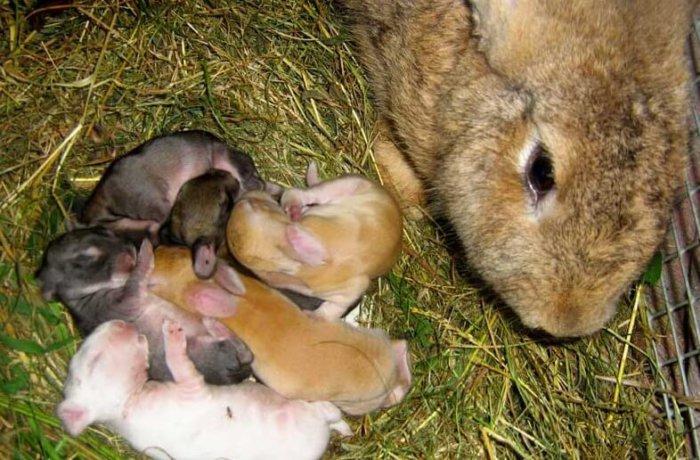
Introduction of dressings
New food is given to rabbits from 3-4 weeks of age. At first, these are herbs dried in the sun. At the age of one month, rabbits are given grated carrots and pumpkin. Gradually, feed beets, turnips, cabbage are introduced into the diet. Little by little, rabbits are beginning to accustom themselves to cereal crops. First, they are given oatmeal. Then cereal mixtures are prepared from crushed grain of wheat, barley, corn, oats. At 45 days of age, they are given boiled potatoes, wet steamed cereal mash.
Important! For the formation of a healthy microflora and normal intestinal function, rabbits at 3-4 weeks of life need to be given cecotrophs, that is, the morning feces of adult healthy rabbits. Peas (2-3 pieces) are added to hay or grated vegetables.
Advantages and disadvantages of artificial feeding of young animals
Little rabbits, which the rabbit refused, can be fed on their own. In the first month of life, animals mainly feed on milk. At 3-4 weeks, a little dried grass and grated carrots are poured into their feeder. Young rabbits are gradually weaned from milk.

At the age of one month, they are fed like normal animals after being deposited from their mother. Weakened and lagging rabbits in development are mixed with vitamin preparations, probiotics. Of course, artificial feeding is a compulsory measure, but this is the only way to save animals.
Advantages of artificial feeding for rabbits:
- get the necessary nutrition;
- quickly get used to new food;
- easily digest food;
- gain weight regularly.
Disadvantages of artificial feeding:
- the formation of the swallowing reflex is slow;
- during each feeding, the presence of a person is necessary;
- it is impossible to replace rabbit milk with identical ones.
Motherless rabbits can be saved. True, for this they will have to be transferred to artificial feeding. The main thing is to teach animals to suck milk from a nipple or pipette. You need to feed the rabbits very carefully. If they just have a stream of milk in their mouths, they can choke and die.
